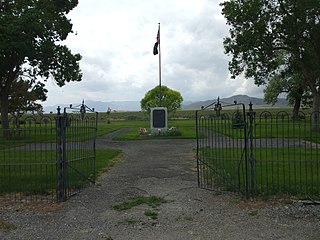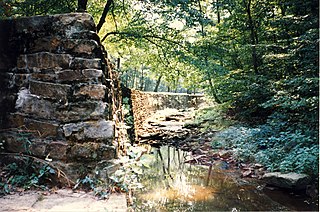
Camp Floyd was a short-lived U.S. Army post in the Cedar Valley, Utah, United States. The Stagecoach Inn was a nearby hotel which also served as a stagecoach stop and, during 1860–1861, a Pony Express stop. Both were listed on the National Register of Historic Places in the 1970s, and now are included in a Utah state park known as Camp Floyd / Stagecoach Inn State Park and Museum.

Pipe Spring National Monument is a United States National Monument located in the U.S. state of Arizona, rich with American Indian, early explorer, and Mormon pioneer history. Administered by the National Park Service, Pipe Spring was listed on the National Register of Historic Places on October 15, 1966, and the boundaries of the Pipe Spring National Monument Historic District were expanded in October 2000.

Camp Douglas was established in October 1862, during the American Civil War, as a small military garrison about three miles east of Salt Lake City, Utah, to protect the overland mail route and telegraph lines along the Central Overland Route. In 1878, the post was renamed Fort Douglas. It was officially closed in 1991 pursuant to BRAC action and most of the buildings were turned over to the University of Utah. A small section of the original fort is still used by the U.S. Army Reserve and includes the Fort Douglas Military Museum. The fort was designated a National Historic Landmark in 1975, for its role in the Civil War and in furthering the settlement of Utah.

The Ribault Club is an historic building on Fort George Island near Jacksonville, Florida. It is now home to the Fort George Island Visitor Center. The building was designed in a Colonial Revival architecture style and is credited to Maurice Fatio and Mellen Clark Greeley. It was added to the U.S. National Register of Historic Places on May 11, 2000 and is located on Fort George Road. It was built in 1928 for winter recreation and is considered a legacy of Fort George Island's resort era. Winter recreational opportunities included golf, tennis, hunting, fishing, and yachting. The building is listed as a Historic Landmark by the City of Jacksonville. It became part of the Fort George Island Cultural State Park in 1989.

Giant City State Park is an Illinois state park on 4,000 acres (1,619 ha) in Jackson and Union Counties, Illinois, United States. Illinois acquired more than 1,100 acres (450 ha) in 1927, and dedicated the park as Giant City State Park. A lodge and visitor center welcome state park guests.

Fort Deseret is a former fort located in northeastern Millard County, Utah, United States, just south of Deseret.

Cedar Island Light is a lighthouse in Cedar Point County Park in East Hampton, New York. It overlooks Gardiners Bay.

The University of Utah Circle, also known as Presidents Circle, is located on the campus of the University of Utah in Salt Lake City, Utah, United States. It was listed on the National Register of Historic Places in 1978 as a historic district.

Edge of the Cedars State Park Museum is a state park and museum of Utah, USA, located in Blanding. It is an Ancestral Puebloan archaeological site, a museum, and an archaeological repository. Cowboys from the nearby town of Bluff camped there in the late 19th century and called the site Edge of the Cedars because it sits on the edge of a natural boundary, separating a heavily forested region and a treeless landscape to the south. Cedar is a term locals use for the Utah juniper tree.

Fort Cameron was a United States Military installation, located east of Beaver, Utah.

The Cedar Rapids Scottish Rite Temple, also known as the Scottish Rite Masonic Center, is a historic building located at 616 A Avenue, Cedar Rapids, Iowa. It is listed on the National Register of Historic Places (NRHP) as Consistory Building No. 2
Cannon & Fetzer was an American architectural firm that operated between 1909-1937 in Salt Lake City, Utah. Lewis T. Cannon and John Fetzer were the principal architects. A number of its works are listed on the U.S. National Register of Historic Places. For a brief time between 1910-1915, the firm was named Cannon, Fetzer & Hansen after partnering with Ramm Hansen. Many of their works survive and are listed on the U.S. National Register of Historic Places.

The Cedar Grove Rosenwald School near Olmstead, Kentucky is a Rosenwald School that was built in 1928. It includes Bungalow/craftsman architecture. It was listed on the National Register of Historic Places in 2002.

The Utah State Training School Amphitheater and Wall, is an amphitheater and boundary wall in northwest American Fork, Utah, United States, that is listed on the National Register of Historic Places.

The Caretaker's Cabin is a historic log cabin in the Cedar Breaks National Monument in southeastern Iron County, Utah, United States, that is listed on the National Register of Historic Places (NRHP).

The Visitor Center is a historic log cabin in the Cedar Breaks National Monument in southeastern Iron County, Utah, United States, that is listed on the National Register of Historic Places (NRHP).

Coggon Public School, also known as the Coggon Center, is a historic building located in Coggon, Iowa, United States.

Cedar Rapids Central Fire Station, also known as Cedar Rapids Hose Company No. 1 and the Cedar Rapids Science Station, is a historic building located in Cedar Rapids, Iowa, United States. It served as the city's fire department headquarters and downtown fire station from 1918 to 1985. It replaced a frame structure in the northeast quadrant, and was part of a larger program of building new facilities for the local fire department. The building program was a response to a series of disastrous fires, changing technology, and the city's growth. This fire station served from the era of horse-drawn pumper wagons to the modern era of fire engines, pumpers, and hook and ladder trucks. The two-story, brick Mission and Spanish Colonial Revival structure was designed by local architect Charles A. Dieman. In the mid-20th century a two-story kitchen addition was built onto the back of the building.

The former First Church of Christ, Scientist, also known as The City Church, is located in Cedar Rapids, Iowa, United States. Christian Science began in Boston in 1866 and it was introduced to Cedar Rapids twenty years later. A Sunday School was established in 1887 and it met at the old Dows Auditorium at Third Avenue and Third Street SE. The congregation was established in 1891 as an official branch of The First Church of Christ, Scientist in Boston. It was the first Christian Science congregation established in Iowa. They held their Wednesday evening services at the Peoples Unitarian Universalist Church. The congregation began construction on this building in 1914 and it was dedicated on Easter Sunday the following year. It is a red brick structure in the Neoclassical style. The rectangular building features a portico with four columns in the Doric order on the main facade, and a centered raised gable roof with cornice returns. The architectural style was chosen to "attract non-churchgoing people that may be intimidated by traditional religious structures." The congregation has subsequently moved to a new facility on Blairs Ferry Road, NE. This building was listed on the National Register of Historic Places in 2017.

The Whittier School in Logan, Utah, at 280 North 400 East, was built in 1908. It was listed on the National Register of Historic Places in 2000.





















